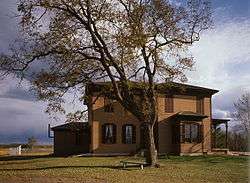Oliver H. Kelley Homestead
The Oliver Kelley Farm is a historic farmstead in Elk River, Minnesota. It was once owned by Oliver Hudson Kelley, one of the founders of the Order of Patrons of Husbandry. The farmstead is a U.S. National Historic Landmark, which also places it on the National Register of Historic Places. The farm is currently operated as a historic site by the Minnesota Historical Society. It was declared a National Historic Landmark in 1964.[2][3]
Oliver H. Kelley Homestead | |
 The Kelley Homestead in Elk River | |
  | |
| Location | 15788 Kelley Farm Rd. Elk River, MN 55330 |
|---|---|
| Coordinates | 45°15′35″N 93°32′12″W |
| Area | 189 acres (76 ha) |
| Built | 1850 |
| NRHP reference No. | 66000406 |
| Significant dates | |
| Added to NRHP | October 15, 1966[1] |
| Designated NHLD | July 19, 1964[2] |
History
Oliver Kelley moved to Minnesota in 1849, the year that Minnesota Territory was formed. Although he knew little about farming, he taught himself using agricultural journals and correspondence with other "scientific-oriented" farmers. He became an expert on farming in Minnesota, and he learned how adverse events such as bad weather, debt, insect pests, and crop failures could devastate a farmer's fortunes.[4] In 1864, he became a clerk in the United States Department of Agriculture. After the end of the American Civil War, he toured the agricultural resources of the Southern states. When he returned to Washington, he was convinced that farmers' fortunes could be improved through cooperative associations with other farmers. Along with several other associates, he founded the National Grange of the Order of Patrons of Husbandry in 1867. He later returned to Minnesota with the hope of organizing local Granges.[3][5]
The farm remained in the ownership of the Kelley family until 1901. The National Grange bought the farm in 1935 and donated it to the Minnesota Historical Society in 1961. Today, the farm offers tours by guides in period costume, who invite visitors to help out with farm chores such as picking vegetables, churning butter, and making soap.[4]
In 2003, state budget shortfalls threatened closure for the historical site. In response, the group Friends of the Kelley Farm was organized to help raise money to close the funding gap. The Friends group also supports the educational goals of the site and works for the site's preservation.[6]
In 2017, the Minnesota Historical Society opened a new visitor center and modern Farm Lab area with a barn, garden and cropland. These new facilities in combination with Kelley's historic 1860s farmstead allow the historic site to explore agricultural history from the 1860s through modern day.[7]
See also
- Open-air museum
- List of National Historic Landmarks in Minnesota
- National Register of Historic Places listings in Sherburne County, Minnesota
References
- "National Register Information System". National Register of Historic Places. National Park Service. March 13, 2009.
- "Oliver H. Kelley Homestead". National Historic Landmark summary listing. National Park Service. Archived from the original on 2011-06-06. Retrieved 2009-09-09.
- Stephen Lissandrello (December 30, 1975). "National Register of Historic Places Inventory-Nomination: Oliver H. Kelley Homestead" (pdf). National Park Service. Cite journal requires
|journal=(help) and Accompanying 3 images from 1969 and 1975. (1.24 MB) - "About the Kelley Farm". Minnesota Historic Sites: Oliver H. Kelley Farm. Minnesota Historical Society. Retrieved 2007-02-23.
- Lass, William E. (1998) [1977]. Minnesota: A History (2nd ed.). New York, NY: W.W. Norton & Company. ISBN 0-393-04628-1.
- "About the Friends". Friends of the Kelley Farm. Archived from the original on March 16, 2005. Retrieved 2007-02-23.
- http://www.mnhs.org/media/news/7682